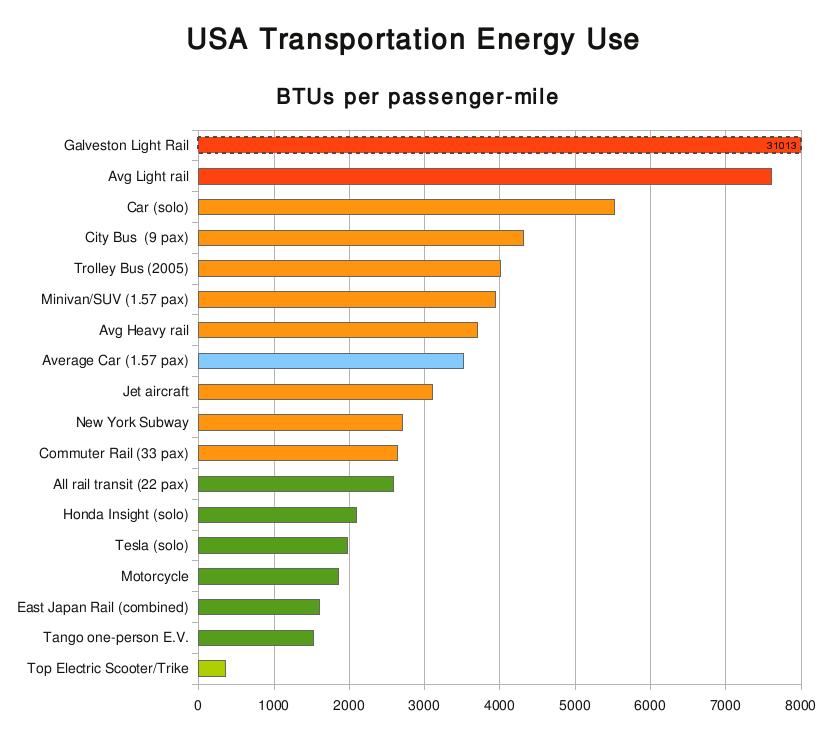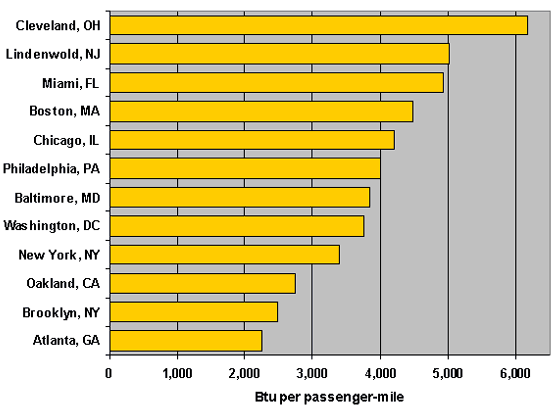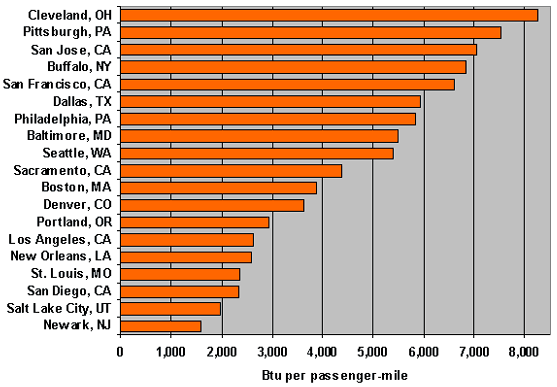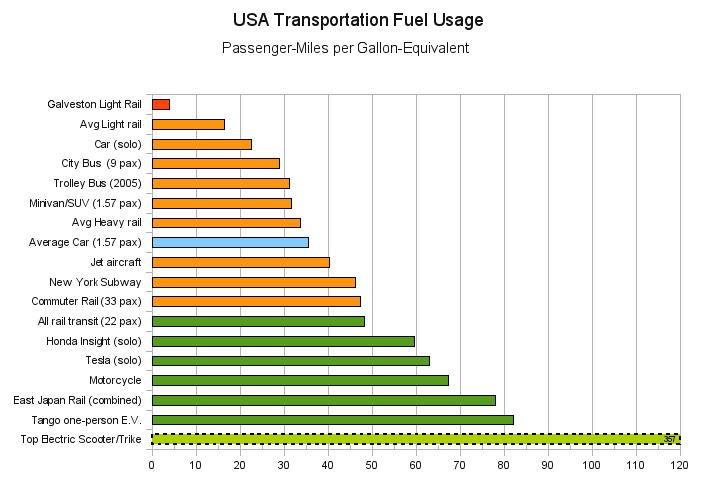
Brad Templeton Home
Brad Ideas
(My Blog)
ClariNet
Is green U.S. mass transit a big myth?
As part of my research for an article on robotic cars and how they change so much of the world, I've been looking into the energy use of various forms of transportation.
What I learned about public transit in the USA shocked me. I've been a fan of public transit, taking it where it's practical for me, and feeling green about it. That transit is a significantly greener way to get around than private car travel almost goes without saying in our thoughts and discussions.
Disturbingly, this simply isn't true. I started by pulling out various numbers on the energy used per passenger mile of various forms of transportation. These numbers can be found in places like the U.S. government bureau of transportation statistics figures and the Dept. of Energy Transportation Energy Data Book (Especially table 2-12). I've also found tables broken down per city.
These studies express transit energy efficiency in terms of BTUs per passenger-mile. The BTU is the English system unit of energy, and it's equal to 1055 joules. With perfect conversion, there are 3413 BTUs in a kw/h. To turn BTUs/mile into miles per gallon, you divide into 125,000, the number of BTUs you get from burning a gallon of gas. Here's a useful table.
A "passenger mile" is taking one passenger a mile. If it takes 10,000 BTUs to take a vehicle with 10 passengers for one mile, that's 10 passenger miles, and 1,000 BTUs/passenger-mile. For solo vehicles, passenger miles are just miles. The figures below are for the DoE's average passenger loads over the entire USA, unless noted as solo or for a specific district.

(If you prefer to see this as MPG equivalents, check out the bottom of this page.)
The DoE figures describe the average car as using 5500 BTUs/mile (23mpg) or 3,500 BTUs/passenger mile with an average load of 1.57 passengers. This is a "fuel to wheels" number based on burning the gasoline.
Putting the car at 3,500 I was disturbed to learn that city diesel buses and electric trolley buses are both worse than the car in energy efficiency. Light capacity rail systems are much worse, on average, though it varies a lot from city to city. Commuter rail and subway (heavy capacity rail) trains tend to be a bit better, though heavy rail has been getting worse. (Non-hybrid cars are also better at long haul than they are short haul.)
I've put a lot of the figures on this chart. I've thrown in some other interesting forms of transit, including electric cars, scooters, hybrid cars, jet airplanes and more.
Particularly disturbing were the numbers for some of the worst transit systems, notably light (capacity) rail. While my local San Jose system no longer tops the chart, the Galveston, Texas system comes in using 8 times the energy of the average light truck/SUV. (To be fair, the system there is a 7 mile long system used more by tourists than locals. The other worst cities also have fairly short systems, though light rail boosters still support them. The Pittsburg light rail, at around 8,500 has no such excuse for its worse-than-solo-SUV performance.)
It should be noted that the electric vehicles are much more efficient on a "tank to wheels" basis than shown here. However, while 1 kWh of electricity is only 3400 BTUs on a theoretical conversion basis, most electricity is generated from heat, and 70% is generated by burning fossil fuels, mostly coal. So in fact each kWh of electricity consumes 10,339 BTUs using the DoE methodology. That's about a 2/3 loss mostly for generation inefficiency and some transmission loss. See also EIA numbers.
The electric vehicles will generate a modestly smaller amount of greenhouse gasses per BTU than the fuel-burning vehicles, though this varies based on how much nuclear and hydro there is in the local area.
What's not in these numbers
True "well to wheels" analysis includes more factors:
- Energy to make and recycle cars and transit vehicles. For typical cars that's 120 million BTUs, or about 15% extra over a 150,000 mile life-cycle. I don't yet have figures for transit vehicles, however I expect them to do better than 15%. Even if it were zero, the results can't get worsened by more than 15%.
- Energy to build and maintain roads (for cars and buses) and tracks (for trains) or both for street cars. This is significant though in many cases it is already expended.
- Energy to extract, refine and ship fuel, both to cars and diesel transit, and to power plants making electricity for electric transit. For gasoline, this is about a 22% surcharge. I don't yet have figures for the energy cost of mining and shipping coal, or extracting and piping natural gas for electricity. Again, this worsens the results at most 22% for the cars, trucks and diesl buses, but the real penalty is going to be less.
- Variations in the average passenger load of all the vehicles, including the cars, which make some systems highly efficient and others terrible. Likewise, some cities have higher passenger/car figures and others lower. These are, except where noted, national averages.
- The fact that sometimes transit trips require more miles (changing lines) and sometimes fewer miles (private right-of-way).
- Data released this year which slows a slight improving trend for the buses, bringing them slightly ahead of the cars. (This varies from year to year.)
These add-ons apply both to transit and cars, though in different ways. The comparison between purely urban cars and purely urban transit is likely somewhat more favourable for transit -- but I would like to get authoritative numbers, and my instincts suggest it does not change the basic conclusion. Likewise the figures for suburban (highway) cars vs. suburban transit will be less favourable for transit.
It's been asserted that the 1.5 passengers per car average provided by the DoE is biased slightly, in that highway driving has higher loads and urban driving has lighter, but I would like to see real numbers on this. A drop to 1.2 urban would make the car's number 25% worse.
While electric transit still burns fuel (~70% fossil, 20% nuke) it is worth considering that its fuel is not imported like much of the oil cars burn. Electric cars of course compare directly with electric transit.
Since I still see many wanting to dispute these numbers, here's a sidebar on various ways to work these numbers.
If you're comparing gasoline or diesel transit to electric transit, while the BTU figure compares the energy used, there are a lot of possible methodologies one might use for comparing these things, many of which score better for electricity. I have a deeper analysis of this. If you're comparing car to bus, or electri car to electric train, the BTU number works fine.
How can this be?
A full bus or trainload of people is more efficient than private cars, sometimes quite a bit more so. But transit systems never consist of nothing but full vehicles. They run most of their day with light loads. The above calculations came from figures citing the average city bus holding 9 passengers, and the average train (light or heavy) holds 22. If that seems low, remember that every packed train at rush hour tends to mean a near empty train returning down the track. Remember, by definition most passenger experiences are on the fuller vehicles, which is why you probably think the average loads are higher than they are. Even in transit-loving places like Great Britain, the average local bus holds just 10 people. (Much higher in London but lower outside.)
Transit vehicles also tend to stop and start a lot, which eats a lot of energy, even with regenerative braking. And most transit vehicles are just plain heavy, and not very aerodynamic. Indeed, you'll see tables in the DoE reports that show that over the past 30 years, private cars have gotten 30% more efficient, while buses have gotten 60% less efficient and trains about 25% worse. The market and government regulations have driven efforts to make cars more efficient, while transit vehicles have actually worsened.
My figures suggest the city bus moves 3,000lbs of bus for every passenger on average, and still 500lbs per passenger when fully packed at rush hour -- starting and stopping all the time. There is more analysis on my blog.
In order to get people to choose transit, you must offer frequent service, all day long. They want to know they have the freedom to return at different times. But that means emptier vehicles outside of rush hour. You've all seen those huge empty vehicles go by, you just haven't thought of how inefficient they were. It would be better if off-hours transit was done by much smaller vehicles, but that implies too much capital cost -- no transit agency will buy enough equipment for peak times and then buy a second set of equipment for light demand periods.
Transit planning is also driven by different economies. Often transit infrastructure (including vehicles) is paid for by state or federal money, while drivers (but also fuel) are paid from local city budgets. This seems to push local city transit agencies to get bigger vehicles and fewer drivers where they can, since drivers tend to be hired full-time and can't be kept idling in low-demand periods.
Remember again, that these are averages. Some cities (see the charts) do have efficient transit lines, and others have dreadful ones that should not have been built as they were. However, even the most efficient cities don't beat small electric cars.
Yes, you should still take transit
 |
| Heavy Rail Energy Efficiency |
As such, these numbers should not make you feel better about taking your car instead of the train. Particularly solo, since solo drivers are what make the car's average efficiency worse while carpoolers make it better.
These numbers instead are there to guide policy. What sort of transportation infrastructure should we build to be efficient? And, to a more limited extent, what sort of transportation should you support? The math should influence your decisions, and those of city planners who work for you, on what new transit to build, and what to keep running.
Is this fair?
As noted, these are averages. It's slightly fairer to compare city MPG with urban transit, and highway MPG with longer range transit and rail. However, newer hybrid cars actually get better mileage on city streets, and this is how cars are trending. Scooters, electric cars and other such vehicles are better by any standard. (It is for this reason that I concluded that robot cars could solve our transportation energy problem, because by delivering and refueling themselves, they make marketable the use of lightweight, short-range electric vehicles that beat out cars or transit by large margins.)
The DoE uses national power grid averages (50% coal, 20% gas, 20% nuke, 9% Hyrdo, 1% other renewable.) Some of the power grids are much more renewable (more hydro) and others are much more fossil oriented. In the renewable-heavy grids, the electric train/trolley bus figures are better, and involve less pollution. In a comparison with electric cars and scooters to electric trains, the electricity source will be the same, and the scooters win handily.
However, again, arguments about 10% there and 20% here don't alter the basic issue, which is we perceive transit as being much better than cars, several times better. I've seen no modifications of the numbers that make transit as efficient as we commonly perceived it to be.
Transit users, studies show, travel less than car users. Some people decide to live nearer work on transit lines. They shop somewhere close on the transit line, not a remote mall. They tend to have a lower income demographic. It may seem twisted, but because of transit's convenience and speed issues, people are willing to, and do, drive further in cars. Transit use, of course, is also concentrated naturally in areas of higher urban density, where trips can be shorter, and transit's no-need-to-park benefit shines. It is an interesting question as to whether the use of high efficiency lightweight vehicles (electric or gas) instead of transit would alter the equation.
It is also often advanced that the combination of high urband density together with good transit results in shorter trips, more walking and more riders on the transit. This is indeed what happens in many of the cities where transit is more efficient, such as those of Asia and Europe. Debate centers around whether this can be duplicated in younger areas like the USA, and how much urban planning fiat is workable or advisable. This consideration does not modify the situation in today's cities, but may affect planning decisions over decades.
So how to be green?
It seems that often in transit there is a marked disconnect between views of what people should do and what they actually do. U.S. transit systems show these terrible numbers because they have not been able to build the riderships that would make them green. That's a hard fact, though it may change somewhat as gas prices go through the roof.
Transit fares are highly subsidized. It's not uncommon for a $1.50 transit ticket to offer a ride that costs the agency 3-4 times as much to provide. (In U.S. big cities, on average subsidies pay for 44% of rail cost and 69% of bus cost. Suburban buses can see almost 90%.) Cars are also subsidized via roads (which also provide subsidy to buses, trucks and street cars) and via free parking and forced parking construction requirements. To the extent that roads are funded by gasoline taxes -- which varies from place to place -- this is not a subsidy so much as a user fee. I say this not to justify any of the subsidies, but to say it makes it hard to judge the true cost.
My first conclusion is that we would get more efficient by pushing small, fuel efficient vehicles instead of pushing transit, and at a lower cost. Scooters, which are very popular almost everywhere outside the US where they pay much more for fuel, are much more efficient, and would beat transit just about every time. They are not as safe, however.
Moving more people out of SUVs and trucks into highly efficient cars (either hybrid or classic) would also do much more for the environment than transit would.
Next we should do more to encourage carpooling, possibly promoting systems for computerized rideshare. I've seen proposals to replace bus lines with computerized systems to coordinate electronic-thumb hitchhiking, though safety remains a concern in some areas. Every road has tons of spare capacity whizzing by all the time. (Sadly, the taxi monopolies would fight this.)
Transit can be made greener, reversing the trend of poorer efficiency. Unfortunately transit budgets are planned on decade scales, and vehicles are slow to be replaced. Smaller, lighter vehicles with fewer stops would help. Replacing large vehicles at off-peak times with computer coordinated jitney service could also help.
Unfortuantely, since transit is only 1% of total USA transportation energy use, it doesn't matter a great deal how efficient it is. Making it twice as good, or twice as bad, would not significantly alter the energy total. Getting rid of the most inefficient coal plants (that take over 15,000 BTU/kwh) would help everywhere, including transit.
Don't Europe and Asia do better?
Much better. This Australian Study cites figures saying that Western Europeans use only 76% of U.S. BTUs/pm in their private transport, and only 38% in their transit -- 2.5 times more efficient. Rich Asians do even better at transit -- they are almost 4 times as efficient in terms of energy/passenger-mile.
Their private transport is better because they own a lot more motorcycles and scooters, as well as smaller cars. Asians do almost 10x as many miles in motorcyles as Americans. Their transit is better primarily because of ridership. They take 5 to 7 times as many transit trips per person. Asian transit actually attains a higher average speed than private travel, another big booster.
They also have much more efficient vehicles.
Note however that in spite of their much higher ridership, transit in Europe is still only 7% of private vehicle energy use, and I would guess about 5% of total compared to ~1% of total for the USA. Even they have the automobile bug pretty strongly.
Why the myth?
I suspect that you, like me, were very surprised to see these numbers. If they're correct, why do we keep hearing transit advocated as the green solution?
 |
| Light (Capacity) Rail Energy Efficiency |
It should be noted that even New York, the most transit-using city in the USA, clocks in at 2,700 BTUs/p-m for its subway and 3,300 for the average of all its transit systems combined -- only slightly better than cars.
To be fair, some people dispute the numbers and promote different methodologies for calculation of energy efficiency. I am always interested in unbiased sources for convincing new numbers.
You will also see that some transit -- typically the well run and high-use commuter rail systems -- are greener than cars. But only modestly, and often not if considered together with "feeder" bus systems. Not the major green win we've come to believe in. And none are as efficient as electric cars and hybrids with a 1.5 passenger average occupancy.
Indeed, I expect I'll get some angry responses for saying that transit isn't green. I've seen others say this message and their motives are usually called into question, both when they have a bias and when they don't. Many have other reasons to boost transit beyond energy efficiency. And transit does have many benefits, but in today's CO2 aware world, the green story has become the main story.
These numbers are debatable
Certainly the exact calculation of fuel to wheels and well to wheels efficiency numbers always generates a lot of debate, and there is merit to the various arguments. However, I want to step back from arguments which alter the numbers by modest factors like 20%.
That's because the common perception -- it was certainly mine -- was that transit was much greener than the car. That while the Prius driver might be admired, transit was the real green answer. Number tweaks are worth researching but don't change the core premise here -- that the values of cars and transit in the USA are not far apart. Since we need to cut energy use and emissions by severalfold, modest gains don't cut it.
Transit does much more than (not) save energy
This issue is complex because we like transit for other reasons. (Indeed, since it's not green, these are its real sources of value.)
It provides cheap transportation to those who can't drive or can't afford to, like children, the elderly and the homeless. It helps to reduce congestion at rush hour, if done right. (Indeed, it may be argued that without transit, roads could never handle the commuter loads in many areas, and would get more inefficient due to heavier congestion.) It reduces the need for parking and allows efficient one-way trips. And it enforces certain patterns on our cities, reinforcing neighbourhoods in ways we both like and don't like. It's generally safer (against accidents) than car travel, and more often electric, which moves pollution out of cities and over to power plants. You can often get work done on trains, and reading done when a passenger in most vehicles.
As you'll learn in my essay, I believe the future will offer "robocars" -- self driving cars -- which offer all the advantages we seek from transit, and then some. Unlike transit, however, the robocars will be considerably greener than today's ordinary cars. This may even fortell an end for traditional transit.
Of course transit also has many downsides, and these keep people loving their cars. Outside the USA, lower wealth, higher fuel costs and different ethics make transit more successful, but inside, this just isn't the case. Transit also isn't cheap. New transit lines, especially ones needing private right-of-way are hugely expensive, and need massive riderships to justify themselves.
One might argue that all this is moot. Because transit is not a success in the USA, its effect on energy consumption is minor. Mass transit (not counting airlines) consumes only about 1% of the total transportation energy pie. (That's 1/3 of what is used simply running the pipelines that deliver fuel, mostly not for transit! It's similar to the number for recreational boating.)
Notes
Some people reading this have asked, "what's my agenda?" Largely it's energy efficient transportation that people actually want to take. In 32 years since my first job, I've only spent about 3 summers as a full time car commuter, 14 years work-at-home and the rest either train commute or mixed bike and car commute, though mostly car in the winter.
This article was originally written using the 2007 Data Book and has been updated to use figures from the 2009 Data Book. Some numbers, notably light rail and bus ones, took major swings. The rail numbers present some contradictory information, in that it cites a total rail average of 2600, but a light rail average of 7600 and a heavy rail average of 3700. While commuter rail and Amtrak are better, this should not be enough to swing the average so far so I seek more source data.
Chart as Miles Per Gallon
While energy efficiency is best viewed in terms of fuel/mile, most Americans measure cars in terms of miles per gallon. This chart shows the energy use of the various transit modes in passenger miles per gallon of gasoline, or rather the appropriate fuel equivalent of a gallon of gas. (Note that electric vehicles really run on 50% coal, 18% natural gas, 20% nuclear and some renewables, mostly hydro.)
 |
| U.S. Transit Energy in Passenger Miles per Gallon |
The electric scooter or tricycle is off the chart, at a whopping 350 MPG. Small, streamlined lightweight vehicles not meant to go much more than 30-40mph can really be a lot more efficient that anything else. Amazingly, only 1% of the energy in a typical car goes to moving the driver, and transit isn't doing much better, so there's a lot of room for improvement.
Note that this is based on one of the best electric trikes you can get today. The average electric scooter, while still very good, is only about half as good as the best.
Comments
You can leave comments on this essay here.